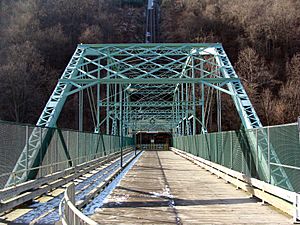Inclined Plane Bridge facts for kids
Quick facts for kids Inclined Plane Bridge |
|
|---|---|
 |
|
| Coordinates | 40°19′33″N 78°55′33″W / 40.32583°N 78.92583°W |
| Carries | SR 3022 spur |
| Crosses | Stonycreek River |
| Locale | Cambria, Pennsylvania, United States |
| Other name(s) | Bridge in Johnstown City |
| Maintained by | PennDOT |
| NBI # | 113022001000000 |
| Characteristics | |
| Total length | 72.2 m (237 ft) |
| Width | 5.7 m (19 ft) |
| Load limit | 5 short tons (4.5 t) |
| History | |
| Constructed by | Sparks and Evans |
| MPS | Highway Bridges Owned by the Commonwealth of Pennsylvania, Department of Transportation TR |
| NRHP reference No. | 88000805 |
| Added to NRHP | June 22, 1988 |
| Lua error in Module:Location_map at line 420: attempt to index field 'wikibase' (a nil value). | |
The Inclined Plane Bridge is a special bridge in Johnstown, Pennsylvania. It stretches 237 feet (about 72 meters) across the Stonycreek River. This bridge is important because it connects the city to the bottom station of the Johnstown Inclined Plane, which is a unique hillside railway.
The bridge uses a design called a Pennsylvania truss. It was added to the National Register of Historic Places in 1988. This means it's recognized as an important historical structure in the United States.
Contents
Building the Inclined Plane Bridge
Why the Bridge Was Needed
On May 31, 1889, a terrible flood hit Johnstown. The South Fork Dam broke, causing a huge amount of water to rush into the city. Over 2,000 people lost their lives in this disaster, known as the Johnstown Flood.
As Johnstown began to rebuild, a company called Cambria Iron Company started building new homes. These homes were on top of a hill called Yoder Hill, overlooking the city. To help people get up and down the steep hill, and to create a safe escape route if another flood happened, they decided to build the Johnstown Inclined Plane. This was like a special train that could climb the hill.
But there was a problem: the incline's lower station was on the other side of the Stonycreek River from Johnstown. So, a bridge was needed to connect the city to the incline.
Construction and Opening
Work on the Inclined Plane Bridge began on June 11, 1890. The builders quickly finished digging out the foundations for the bridge's ends. By March 20, 1891, almost all the main parts of the bridge were done.
The bridge officially opened on June 1, 1891. It opened at the same time as the Johnstown Inclined Plane. This made it much easier for people to travel between the city and the new homes on Yoder Hill.
The Bridge During the 1936 Flood
The bridge played a very important role during another flood on March 17, 1936. The Stonycreek and Conemaugh Rivers overflowed their banks. Nearly 4,000 people used the bridge and its pathway to escape to higher ground using the incline. The bridge helped many people get to safety during this difficult time.
Repairs and Renovations
After the 1936 flood, the bridge needed repairs. In October 1936, money was set aside to fix the bridge's pathway. They also replaced parts of the bridge's structure, like the handrails and the road surface.
In 1964, the state's transportation department took over the bridge. It was officially listed on the National Register of Historic Places in 1988. This recognized its historical importance.
More recently, from 2000 to 2001, the bridge went through a big renovation. This project cost $2.3 million. The work was paused for a few months in 2001 so the incline could still operate. The renovations were completed on December 14, 2001, making the bridge strong and safe for many more years.
How the Bridge Was Built
The Inclined Plane Bridge was constructed using wrought iron and steel. These materials were joined together with rivets to form a special design called a Pennsylvania truss.
Understanding a Pennsylvania Truss
A truss is a framework of connected beams that supports a bridge. The Pennsylvania, or Petit, truss is a type of bridge design. It's like a Pratt truss but with some extra features. The top and bottom parts of the truss are often shaped with many sides, not just straight lines. Also, it has extra smaller sections inside the main framework. These extra parts help make the bridge stronger, especially when heavy loads cross it.
The Inclined Plane Bridge is 237 feet long. This is actually a bit short for a Pennsylvania truss bridge. Most bridges using this design are usually between 250 and 600 feet long. Even so, its design makes it a very strong and lasting structure.

